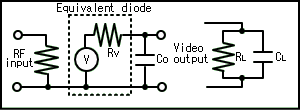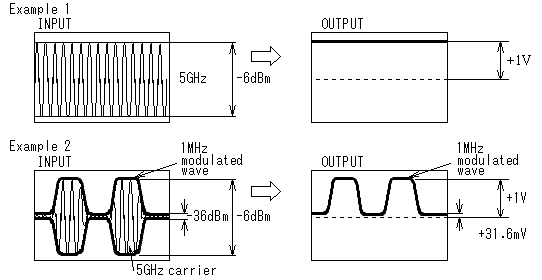
MMD850 Microwave AM detector
Detects AM wave of 2 to 8GHz in 30dB dynamic range.

Microwave AM detector MMD850 performs AM detection of signal of 2 to 8GHz (available for 1 to 15GHz range as special order) in 30dB dynamic range. It may be used for evaluation of W-CDMA, CDMA, GSM, PDC, PHS, wireless LAN, Bluetooth and wireless communication equipment including evaluation of ETC signals.
Coaxial type AM detector has two disadvantages in the application indicated below : The first is that the dynamic range is narrow. The curve is non-linear when the input is more than +5dBm or less than -10dBm as shown below. Therefore, the workable range is only +15dBm. It is provided, however, that when the peak level of input is less than +5dB, -6dBm for instance, the dynamic range is even narrower and drops to 4dB. Narrow dynamic range means that the waveform is collapsed.

Coaxial type AM detector in / out characteristics
¡@
The
second is video output frequency band. The equivalent circuit of coaxial type AM
detector (Rv = 1.5kohm, Co = 30pF) of a certain manufacturer is shown below. The
case where observation is performed with this AM detector connected to an
oscilloscope (RL = 1Mohm, CL2 = 25pF) using 1 meter coaxial cable (CL1 = 100pF)
is taken into account.
Tr = 0.35 / fb = 2.2RvRL (Co + CL1 + CL2) / (Rv + RL)
Therefore, rising time Tr = 511 [ns] and frequency band fb = 685 [kHz]. It is
learnt that the band is lower than what was imagined.
¡@

Coaxial type AM detector equivalent circuit
¡@Explanation of MMD850
The
block diagram of microwave AM detector MMD850 is shown below. When a microwave
amplifier and linearizer are added to it, 30dB dynamic range is secured against
signals of peak level more than -6dBm and up, and in addition, 10MHz bandwidth
is secured without being affected by the load.

MMD850 block diagram
¡@
Against
signals of peak level more than -6dBm, it is possible to observe signals without
spoiling the dynamic range when fixed attenuator is located to the input. If
three attenuators of 3dB, 6dB and 12dB are prepared, for example, it is possible
to perform observation in at least 27dB dynamic range, against signals of peak
level -6dBm to +15dBm. Furthermore, due to the fact that the output impedance of
the liberalize is 50ohm, it is possible to perform observation without being
affected by the load, when the output is terminated with 50ohm.
Input signals and detected output waveforms are indicated below. Example 1 is
the case where continuous wave or FM wave of -6dBm is input. +1V DC voltage is
produced as the detected output. Example 2 is the case where ASK signals of peak
level -6dBm and bottom level -36dBm (modulation factor 94%) is input. A waveform
of peak level +1V and bottom level +31.6mV is output.
¡@

Input signal and detected output waveform
¡@
| Specifications | |
| Input characteristics | |
| Input frequency range | 2 to 8GHz |
| *Available for 1 to 15GHz range as special order | |
| Optimum input level | -6dBm @ peak level |
| Dynamic range | 30dB @ -6dBm input |
| VSWR | less than 1.4 |
| Input damage level | +13dBm |
| Output characteristics | |
| Output frequency range | DC to 10MHz @ -3dBm |
| Output voltage | +1.0V @ 50ohm load and -6dBm input |
| Polarity | positive polarity 50ohm |
| Output impedance | 90 to 132VAC, 50 / 60Hz |
| General | |
| Power source | 320 (W) ¡Ñ 56 (H) ¡Ñ 350 (D) mm (excluding projections) |
| Dimensions | Operation manual (1pc), Fuse (1pc), Power cable (1pc) |
| Standard accessories | |
Products list | brand | Model No. | Home